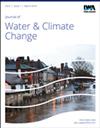Spatio-temporal drought assessment and comparison of drought indices under climatic variations in drought-prone areas of Pakistan
IF 3.1
4区 环境科学与生态学
Q2 WATER RESOURCES
引用次数: 0
Abstract
Abstract Climatic variations cause droughts which badly affect the environment. The study focused on monitoring droughts to aid decision-making and mitigate their negative impacts on water availability for agriculture and livelihoods in the face of increasing water demand and climate change. To assess the agricultural droughts, a new agricultural Standardized Precipitation Index (aSPI) was calculated which is not used earlier in Balochistan. Widely recommended Standardized Precipitation Index (SPI) and Standardized Precipitation Evapotranspiration Index (SPEI) were used for meteorological drought assessment. Drought indices comparison was also conducted to check the applicability. Rainfall, maximum temperature, and minimum temperature data (1992 to 2021) were utilized to calculate SPI, aSPI, and SPEI at different timescales (3, 6, 9, and 12 months) using DrinC software and SPEI calculator. Indices results revealed the following severe to extreme drought years: 1998, 1999, 2000, 2001, 2002, 2004, 2008, 2011, 2014, 2016, and 2017. It was determined that Dalbandin, Quetta, Sibi, Kalat, Khuzdar, and Zhob experienced higher extreme drought frequencies. Both long- and short-term drought durations were observed. Indices comparison showed that SPI is the most efficient drought index compared to aSPI and SPEI. This study offers valuable insights for managing water resources in the face of climate-induced droughts.巴基斯坦干旱易发地区气候变化下干旱时空评价及干旱指数比较
气候变化导致干旱,严重影响环境。该研究的重点是监测干旱,以帮助决策,并在水资源需求增加和气候变化的情况下减轻干旱对农业和生计用水的负面影响。为了评估农业干旱,计算了一个新的农业标准化降水指数(aSPI),该指数在俾路支省以前没有使用过。标准化降水指数(SPI)和标准化降水蒸散指数(SPEI)被广泛推荐用于气象干旱评价。并对干旱指标进行了比较,以验证其适用性。利用1992 ~ 2021年降水、最高气温和最低气温资料,利用DrinC软件和SPEI计算器计算不同时间尺度(3、6、9和12个月)的SPI、aSPI和SPEI。指数结果显示,1998年、1999年、2000年、2001年、2002年、2004年、2008年、2011年、2014年、2016年和2017年是中国的严重至极端干旱年份。结果表明,达尔班丁、奎达、西比、卡拉特、库兹达尔和乔布经历了更高的极端干旱频率。观察到长期和短期干旱持续时间。指数对比表明,SPI是最有效的干旱指数,相对于aSPI和SPEI。这项研究为面对气候引起的干旱时管理水资源提供了有价值的见解。
本文章由计算机程序翻译,如有差异,请以英文原文为准。
求助全文
约1分钟内获得全文
求助全文
来源期刊

Journal of Water and Climate Change
WATER RESOURCES-
CiteScore
4.80
自引率
10.70%
发文量
168
审稿时长
>12 weeks
期刊介绍:
Journal of Water and Climate Change publishes refereed research and practitioner papers on all aspects of water science, technology, management and innovation in response to climate change, with emphasis on reduction of energy usage.
 求助内容:
求助内容: 应助结果提醒方式:
应助结果提醒方式:


